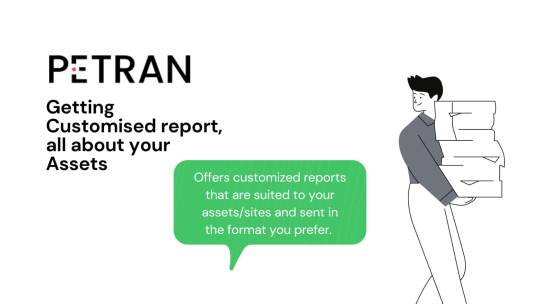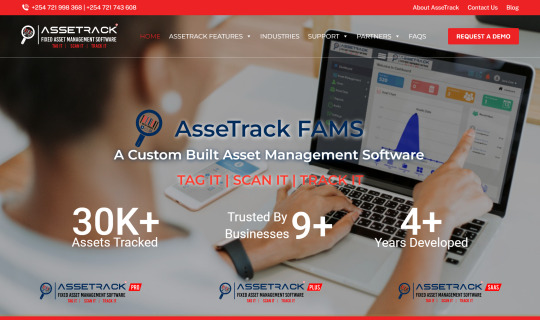#AssetTrackingSystem
Explore tagged Tumblr posts
Text
Find out the Best Asset Management Software - Emossy
Looking for the best asset management software? Discover the top solution designed to streamline your asset tracking, maintenance, and overall management. Learn how this software can optimize your operations, improve efficiency, and save costs. To know more, visit: https://www.emossy.com/asset-management-system/
#bestassetmanagementsoftware#assetmanagementsoftware#assettrackingsolution#assetmanagementsystem#assettrackingsystem#emossy
1 note
·
View note
Text
Transform Your Business Overnight: Witness the Impact of Cutting-Edge Asset Management tools

In today’s dynamic business environment, efficiency and precision are paramount for success. Every asset, whether tangible or intangible, plays a crucial role in the smooth functioning of a business. However, managing these assets effectively has traditionally been a daunting task, often riddled with inefficiencies and complexities. That is until now. With Tracet Asset management software, businesses have the opportunity to witness a transformative impact on their operations virtually overnight.
Seamless Integration and Accessibility
Tracet Asset management software stands apart from conventional asset management tools — it’s a holistic solution engineered to streamline asset management processes from inception to completion. With its user-friendly interface and effortless integration features, Tracet empowers businesses to consolidate all asset-related data into a single accessible platform. Bid farewell to scattered spreadsheets and disjointed systems Tracet brings everything together in a unified, easy-to-navigate dashboard.
Optimized Asset Lifecycle Management
Tracet’s remarkable capability lies in its comprehensive optimization of the asset lifecycle. From the initial acquisition and deployment to ongoing maintenance and eventual disposal, Tracet equips businesses with a suite of tools to extract maximum value from their assets at every juncture. By seamlessly integrating automated workflows, predictive analytics, and proactive maintenance scheduling, Tracet Asset management software guarantees that assets consistently operate at peak performance levels. This proactive approach minimizes downtime, enhances productivity, and ensures that businesses derive optimal returns from their investments.
Comprehensive Compliance and Reporting
Compliance with regulatory standards and financial reporting requirements is a top priority for businesses across industries. With Tracet, businesses can rest assured knowing that they are always in compliance with relevant regulations. Tracet’s robust reporting capabilities provide businesses with comprehensive insights into asset depreciation, maintenance histories, and audit trails, ensuring transparency and accountability at every stage.
Data-Driven Decision-Making
In today’s world, using data to make smart decisions is really important to beat competitors. Tracet Asset management software helps businesses a lot by giving them useful information from real-time data analysis. It helps them find ways to save money, use their assets better, and plan for the future. With Tracet, businesses can make decisions that help them grow and make more money.
Imagine having a tool at your fingertips that not only provides you with data but also transforms it into actionable insights. With Tracet Asset management software, you can visualize trends, identify patterns, and make decisions that have a direct impact on your bottom line. Don’t settle for guesswork — let Tracet guide you towards smarter, more profitable choices.
Ready to unlock the power of real-time data analytics and drive your business towards success? Take action now and explore what Tracet can do for you. Don’t let your competition get ahead — harness the insights that Tracet offers and propel your business towards a brighter future. Click here to learn more and get started today!
#AssetManagementSoftware#AssetTracking#InventoryManagement#MaintenanceSoftware#EnterpriseAssetManagement#AssetLifecycleManagement#AssetTrackingSoftware#AssetSoftware#AssetTrackingSystem#AssetManagement#Maintenance#Efficiency
0 notes
Text
#SchoolAssetManagement#FacilitySoftware#AssetTracking#CampusManagement#FacilityOptimization#AssetTrackingSystem
0 notes
Text

#iot & #airport asset tracking offers an automated, remotely managed, and linked way of monitoring and controlling geo-position and movement aspects of an asset's life cycle and operation using sensors, connected devices, and sophisticated #dataanalytics.
www.petran.io
#dataanalytics.#assettrackingsystem#assettrackingsolution#assettracking#asset#tracking#assetsafety#GPSTracking#GPS#securitysystem#security#securitycamera#accesscontrol#securitycameras#cctvcamera#surveillance#assetstrackingsoftware#fixedasset#fixedassetmanagement#tracing#fixedassettracking#petranassettracking#32m
2 notes
·
View notes
Text
𝐒𝐜𝐚𝐥𝐢𝐧𝐠 𝐨𝐩𝐞𝐫𝐚𝐭𝐢𝐨𝐧𝐬 𝐚𝐧𝐝 𝐚𝐜𝐡𝐢𝐞𝐯𝐢𝐧𝐠 𝐭𝐡𝐞 𝐭𝐚𝐫𝐠𝐞𝐭𝐬 𝐢𝐬 𝐞𝐯𝐞𝐫𝐲 𝐜𝐨𝐦𝐩𝐚𝐧𝐲'𝐬 𝐩𝐫𝐢𝐦𝐚𝐫𝐲 𝐠𝐨𝐚𝐥.

I’ve put together our top five recommendations to help research SMBs improve their operational efficiency and productivity using workflow management systems.
I'd be more than happy to hear your feedback when it comes to scaling and optimizing operations.
https://www.linkedin.com/pulse/how-can-smbs-scale-optimize-operations-improve-work-efficiency-patel/
𝗚𝗲𝘁 𝗼𝗻 𝗮 𝗗𝗶𝘀𝗰𝗼𝘃𝗲𝗿𝘆 𝗖𝗮𝗹𝗹 𝘄𝗶𝘁𝗵 𝗼𝘂𝗿 𝗲𝘅𝗽𝗲𝗿𝘁 𝘁𝗼𝗱𝗮𝘆 𝗮𝗻𝗱 𝗺𝗮𝗸𝗲 𝗮𝗻 𝗶𝗻𝗳𝗼𝗿𝗺𝗲𝗱 𝗯𝘂𝘀𝗶𝗻𝗲𝘀𝘀 𝗱𝗲𝗰𝗶𝘀𝗶𝗼𝗻.
Our experts will be more than happy to help you out, email us at [email protected] | Call us on +91 93281 35112...
#Operations#ScalingBusiness#ProcessImprovement#BusinessGoals#Leadership#WorkflowManagement#AssetTrackingSystem#SaaS
1 note
·
View note
Text
#fixedassets#assettagging#assettaggingformat#physicalasset#mobileapps#manageandtrack#assetswithbarcodes#barcodelabels#barcodescanner#assetdata#barcodesystem#qrcodes#mobiledevice#barcodescanning#barcodeassettrackingsoftware#manageassets#manualdataentry#inventorymanagement#realtime#assettrackingsystem#assetmanagementsystem
0 notes
Link
Healthcare asset tracking deals with tracking and locating assets in a healthcare facility. It can include tracking basic of assets like bandages or pharmaceuticals, to MRI equipment and even biomedical assets. Asset tracking systems make use of asset management software in order to provide healthcare administrators an integrated interface to manage all the assets in the facility. Pycube provides hospitals and healthcare facilities with cutting edge asset management solutions to help them deliver sustainable healthcare solutions.
https://www.pycube.com/
21525 Ridgetop Circle,Suite 110, Sterling, 20166.
1-800-866-8583
0 notes
Link

Businesses need efficient asset tracking systems to locate an asset, its current condition, lifecycle, and control processes. Click this link to learn how IoT based Asset Tracking Solutions make it possible. http://bit.ly/2MUQHRw
#AssetTrackingSystem#IoTDevelopment#IoTSolutions#IoTConsulting#Business#IoT Consulting#iot app development
0 notes
Link
0 notes
Text
7 Benefits to Invest in the Best Asset Management Software 2024
Discover the top 7 reasons why investing in the best asset management software in 2024 is essential for your business success. Track and organize employee assets effortlessly. Checkout our latest blog here: https://shorturl.at/uwADI
#bestassetmanagementsoftware#assettrackingsolution#assetmanagementsoftware#assetmanagementsystem#assettrackingsystem#emossy
1 note
·
View note
Text
Unlock the power of Tracet’s state-of-the-art Asset Management Software solutions to empower your business.

In today’s fast-paced and competitive business landscape, effective asset management is paramount for success. As companies strive to optimize operations, reduce costs, and maximize efficiency, the role of Asset management software becomes increasingly critical. Tracet stands at the forefront of this evolution, offering cutting-edge solutions designed to empower businesses across industries.
Tracet’s Asset management software transcends mere asset tracking — it’s a holistic platform meticulously crafted to streamline workflows, elevate decision-making, and fuel business expansion. Through harnessing cutting-edge technologies and pioneering features, Tracet emboldens organizations to assert unprecedented control over their assets.
Tracet’s software boasts a pivotal edge: the capability to offer instantaneous insight into asset performance and usage. With user-friendly dashboards and adaptable reports, companies can glean invaluable perspectives into their asset lifecycle, empowering proactive maintenance and optimization tactics. Be it equipment downtime, maintenance expenses, or asset depreciation, Tracet furnishes users with the requisite data to forge informed decisions and foster ongoing enhancement.
Furthermore, Tracet’s Asset management software is built to scale with your business. Whether you’re a small startup or a large enterprise, Tracet offers flexible solutions tailored to your unique needs. With cloud-based deployment options and seamless integration capabilities, Tracet ensures that your asset management processes remain agile and adaptable, even as your business grows and evolves.
Tracet takes security seriously. Their software comes with strong security measures to keep your valuable asset data safe. They use encryption and access controls to make sure only authorized users can access the information. This means you can manage your assets with peace of mind, knowing your data is protected from cyber threats and unauthorized access.
Tracet sets itself apart not only with its impressive features but also with its dedication to keeping customers happy. They have dedicated support teams that go the extra mile to make sure every client gets the help they need to get the most out of their investment. Whether it’s helping with setting up the software, providing training, or offering ongoing support, Tracet Asset management software is there for you every step of the journey.
Imagine having real-time visibility into your assets’ performance, utilization, and maintenance needs at your fingertips. With Tracet, this becomes a reality. Our intuitive dashboards and customizable reports provide valuable insights to help you make informed decisions and drive continuous improvement.
Don’t let outdated asset management processes hold your business back. Take the first step towards empowerment with Tracet’s state-of-the-art Asset management software solutions. Contact us today to unlock the power of your assets and propel your business to new heights!
#AssetManagementSoftware#AssetTracking#InventoryManagement#MaintenanceSoftware#EnterpriseAssetManagement#AssetLifecycleManagement#AssetTrackingSoftware#MaintenanceManagement#MaintenanceTracking#AssetMonitoring#AssetPerformanceManagement#AssetOptimization#MaintenanceAutomation#WorkOrderManagement#AssetMaintenance#AssetInventory#EquipmentManagement#MaintenanceSystem#AssetSoftware#AssetTrackingSystem#MaintenancePlanning#AssetUtilization#AssetEfficiency
0 notes
Text
Optimize your inventory with our asset management system for universities. Streamline operations, maximize efficiency, and save costs.
0 notes
Photo

Everyone in the trucking industry knows that the demand for drivers is on the constant rise. A 2017 report by the American Trucking Association revealed that the industry wants to hire almost an additional 900,000 more drivers to meet rising demand. Statistics show that a large percentage of current truck drivers are over 50 years old or more. The matter is that older, more qualified truck drivers are retiring without adequate replacements.
#assettrackingdevice#mobileassettracking#gpsassettracking#assetmonitoringsystem#assettrackingsystem#gpsassettrackingdevice#assetgpstrackingsystem#bestassettracker
0 notes
Text
How RFID Container Tracking System can Revitalize Your Business Operations and ROI?
Our Asset Track RFID system offers a solution that helps users can track the assets of an organization located throughout different locations.
1 note
·
View note
Text
10 Reasons Your Organization Needs An Asset Management Systems

An asset management systems is a platform that helps your company monitor your assets such as investments, equipment, properties, and even vehicles. Contrary to common misconceptions, this kind of strategy not only works for companies that mainly rely on assets such as those in the real estate and transport sectors. Companies from a lot of industries, even small businesses, can benefit from this particular upgrade.
Whether you’re new to the world of asset management systems, or already have one in place, it never hurts to identify and understand the benefits of implementing this monitoring structure. To help improve your organization and streamline your processes, here are ten reasons why you need an asset management system:
1. Keep track of your assets
As the main purpose of an asset management system, having one in place lets you see where they are located. Furthermore, you can also check at a glance the status of these assets. Depending on the system you have, you can check whether these particular assets are currently in use or not, or if they have been updated or modified recently. This is particularly important for manufacturing companies that need to regularly monitor whether their machines all run the required product or if they’ve all been updated with the necessary firmware.
Not only does it protect your assets and give you a handle on their condition, but some systems available allow you to monitor their respective performances. Some asset management solutions allow you to integrate features for collecting data and your target market’s opinion, through metrics such as engagement or even conversion rates.
2. Align your financial records
Proper asset management keeps you updated on the payment status of each–such as amortization rates and schedule for each vehicle, machine, or any other asset you’re still paying– and keeps your financial records accurate. Furthermore, being regularly updated on this front means you don’t miss any of your payments, saving your company from fines and penalties from late or missed amortizations.
3. Streamlines operation
Eliminate the repetitive and tedious task of monitoring and inspecting your vehicles or other properties, especially if they’re located elsewhere. With asset tracking software, you can assign people, even the end-users themselves, to update the conditions of the assets in their care. It reduces the time it takes to assess the assets and the automated forms make it easier for the employees in various levels to see and appreciate the conditions of the equipment or material they’re working with. It ultimately reduces your lead time and lets your people focus on more important work.
4. Eliminate ghost assets
Regardless of what industry your company is in, ghost asset is a logistical nightmare whose effects can slow or even hinder your growth for years to come. These are simply defined as any asset listed in a general ledger, yet can no longer be accounted for.
Whether it’s physically unavailable (missing, misplaced, stolen, or entrusted to an employee no longer with the company) or simply no longer usable, ghost assets usually stem from misreported or unrecorded items. With an asset management system, you can easily monitor where it was last located or who last used it.

When an asset reaches its end of life, companies usually have no choice but to let go of them. Asset recovery is an effort to make the most out of these materials, either by scrapping, selling, or other forms of divestment. With an asset management system, assets that are at their end-of-life are easily identified and once disposed of, can be easily updated.
This allows you to remove them from your books. It also helps you identify consumables and spare parts that were used for or together with the disposed asset–helping you free up storage, plan disposal procedures ahead of time, and prevent the creation of ghost assets.
6. Save on maintenance costs
It’s general knowledge that regular preventive maintenance programs are relatively cheaper than responsive repair efforts. Not only does it prevent otherwise avoidable downtime, which translates to lost revenue, but it also lets you save on parts by planning ahead of time.
If you can see which of your vehicles or machines are due for a parts replacement or even a routine checkup, you can plan ahead and skip additional fees that come with emergency repair works. More importantly, it lets you plan proper maintenance, avoiding the excess costs by overdoing it and the stress on the asset brought about by not doing it enough.
7. Supports risk management plan design and implementation
Risk management in businesses usually covers the evaluation of existing financial risks, forecasting, and projecting future financial plans. More importantly, it lets your organization plan ahead of an upcoming financial challenge. In terms of asset management, you can prevent being blindsided by assets suddenly breaking down due to wear or old age.
As your properties depreciate, you can take the necessary steps to make sure they won’t negatively affect your company. Whether it’s investing for a replacement or stockpiling repair kits, you can have a clearer, more detailed risk management plan with the risks in your assets clearly identified.
8. Reduce incidents of theft and fraud
Proper asset accounting, aided by an asset management platform, can help reduce incidents of theft and fraud. Being able to keep track of your assets’ movements minimizes the risks of items being stolen or lost at any time under your care.
A popular example of these solutions is one that’s being used in some trucking companies. They have integrated features that prevent malicious activities such as opening the trailer in locations other than the destination, tracking fuel consumption with respect to mileage, and even RFID-activated entry and exit. Not only does this prevent wrongful activities from their employees, but also alerts law-enforcement agencies in the event something untoward happens to their drivers and their trucks on the road.
9. Make insurance or lease financing easier
If you have assets located in different locations, it’s usually challenging to keep track of them individually. Even more challenging is the generation of inventory reports that are necessary if you’re filing or renewing your insurance plans. The same goes if you’re looking for financiers and an updated report on your organization’s assets is necessary.
Having asset management programs in your company makes it easier to comply with these requirements. More often than not, you only have to pull up a summarized report plus the individual reports as attachments–a feature included in some online systems today.
10. Helps in developing a budget
As it helps you track the condition and the payment status of each asset in your inventory, you can easily draft a budget. This is especially helpful for small businesses and startups, as the following months are crucial and every dollar you will be earning must be properly budgeted. If you know that your assets can be expected to work or run well for the foreseeable future, then you can start investing in other things. Otherwise, assets nearing their end of life will tell you when to divest and start looking for alternatives in advance.
10 Reasons Your Organization Needs An Asset Management Systems
An asset management systems is a platform that helps your company monitor your assets such as investments, equipment, properties, and even vehicles. Contrary to common misconceptions, this kind of strategy not only works for companies that mainly rely on assets such as those in the real estate and transport sectors. Companies from a lot of industries, even small businesses, can benefit from this particular upgrade.
Whether you’re new to the world of asset management systems, or already have one in place, it never hurts to identify and understand the benefits of implementing this monitoring structure. To help improve your organization and streamline your processes, here are ten reasons why you need an asset management system:
1. Keep track of your assets
As the main purpose of an asset management system, having one in place lets you see where they are located. Furthermore, you can also check at a glance the status of these assets. Depending on the system you have, you can check whether these particular assets are currently in use or not, or if they have been updated or modified recently. This is particularly important for manufacturing companies that need to regularly monitor whether their machines all run the required product or if they’ve all been updated with the necessary firmware.
Not only does it protect your assets and give you a handle on their condition, but some systems available allow you to monitor their respective performances. Some asset management solutions allow you to integrate features for collecting data and your target market’s opinion, through metrics such as engagement or even conversion rates.
2. Align your financial records
Proper asset management keeps you updated on the payment status of each–such as amortization rates and schedule for each vehicle, machine, or any other asset you’re still paying– and keeps your financial records accurate. Furthermore, being regularly updated on this front means you don’t miss any of your payments, saving your company from fines and penalties from late or missed amortizations.
3. Streamlines operation
Eliminate the repetitive and tedious task of monitoring and inspecting your vehicles or other properties, especially if they’re located elsewhere. With asset tracking software, you can assign people, even the end-users themselves, to update the conditions of the assets in their care. It reduces the time it takes to assess the assets and the automated forms make it easier for the employees in various levels to see and appreciate the conditions of the equipment or material they’re working with. It ultimately reduces your lead time and lets your people focus on more important work.
4. Eliminate ghost assets
Regardless of what industry your company is in, ghost asset is a logistical nightmare whose effects can slow or even hinder your growth for years to come. These are simply defined as any asset listed in a general ledger, yet can no longer be accounted for.
Whether it’s physically unavailable (missing, misplaced, stolen, or entrusted to an employee no longer with the company) or simply no longer usable, ghost assets usually stem from misreported or unrecorded items. With an asset management system, you can easily monitor where it was last located or who last used it.
When an asset reaches its end of life, companies usually have no choice but to let go of them. Asset recovery is an effort to make the most out of these materials, either by scrapping, selling, or other forms of divestment. With an asset management system, assets that are at their end-of-life are easily identified and once disposed of, can be easily updated.
This allows you to remove them from your books. It also helps you identify consumables and spare parts that were used for or together with the disposed asset–helping you free up storage, plan disposal procedures ahead of time, and prevent the creation of ghost assets.
6. Save on maintenance costs
It’s general knowledge that regular preventive maintenance programs are relatively cheaper than responsive repair efforts. Not only does it prevent otherwise avoidable downtime, which translates to lost revenue, but it also lets you save on parts by planning ahead of time.
If you can see which of your vehicles or machines are due for a parts replacement or even a routine checkup, you can plan ahead and skip additional fees that come with emergency repair works. More importantly, it lets you plan proper maintenance, avoiding the excess costs by overdoing it and the stress on the asset brought about by not doing it enough.
7. Supports risk management plan design and implementation
Risk management in businesses usually covers the evaluation of existing financial risks, forecasting, and projecting future financial plans. More importantly, it lets your organization plan ahead of an upcoming financial challenge. In terms of asset management, you can prevent being blindsided by assets suddenly breaking down due to wear or old age.
As your properties depreciate, you can take the necessary steps to make sure they won’t negatively affect your company. Whether it’s investing for a replacement or stockpiling repair kits, you can have a clearer, more detailed risk management plan with the risks in your assets clearly identified.
8. Reduce incidents of theft and fraud
Proper asset accounting, aided by an asset management platform, can help reduce incidents of theft and fraud. Being able to keep track of your assets’ movements minimizes the risks of items being stolen or lost at any time under your care.
A popular example of these solutions is one that’s being used in some trucking companies. They have integrated features that prevent malicious activities such as opening the trailer in locations other than the destination, tracking fuel consumption with respect to mileage, and even RFID-activated entry and exit. Not only does this prevent wrongful activities from their employees, but also alerts law-enforcement agencies in the event something untoward happens to their drivers and their trucks on the road.
9. Make insurance or lease financing easier
If you have assets located in different locations, it’s usually challenging to keep track of them individually. Even more challenging is the generation of inventory reports that are necessary if you’re filing or renewing your insurance plans. The same goes if you’re looking for financiers and an updated report on your organization’s assets is necessary.
Having asset management programs in your company makes it easier to comply with these requirements. More often than not, you only have to pull up a summarized report plus the individual reports as attachments–a feature included in some online systems today.
10. Helps in developing a budget
As it helps you track the condition and the payment status of each asset in your inventory, you can easily draft a budget. This is especially helpful for small businesses and startups, as the following months are crucial and every dollar you will be earning must be properly budgeted. If you know that your assets can be expected to work or run well for the foreseeable future, then you can start investing in other things. Otherwise, assets nearing their end of life will tell you when to divest and start looking for alternatives in advance.
#assetrackingsoftware assetmanagementsoftware assettrackingsystem#assetracking#assetmanagementsystem#assetrack#fixedassetmanagementsoftware#fixedassetmanagementsoftwareinkenya#assetrackfams
0 notes